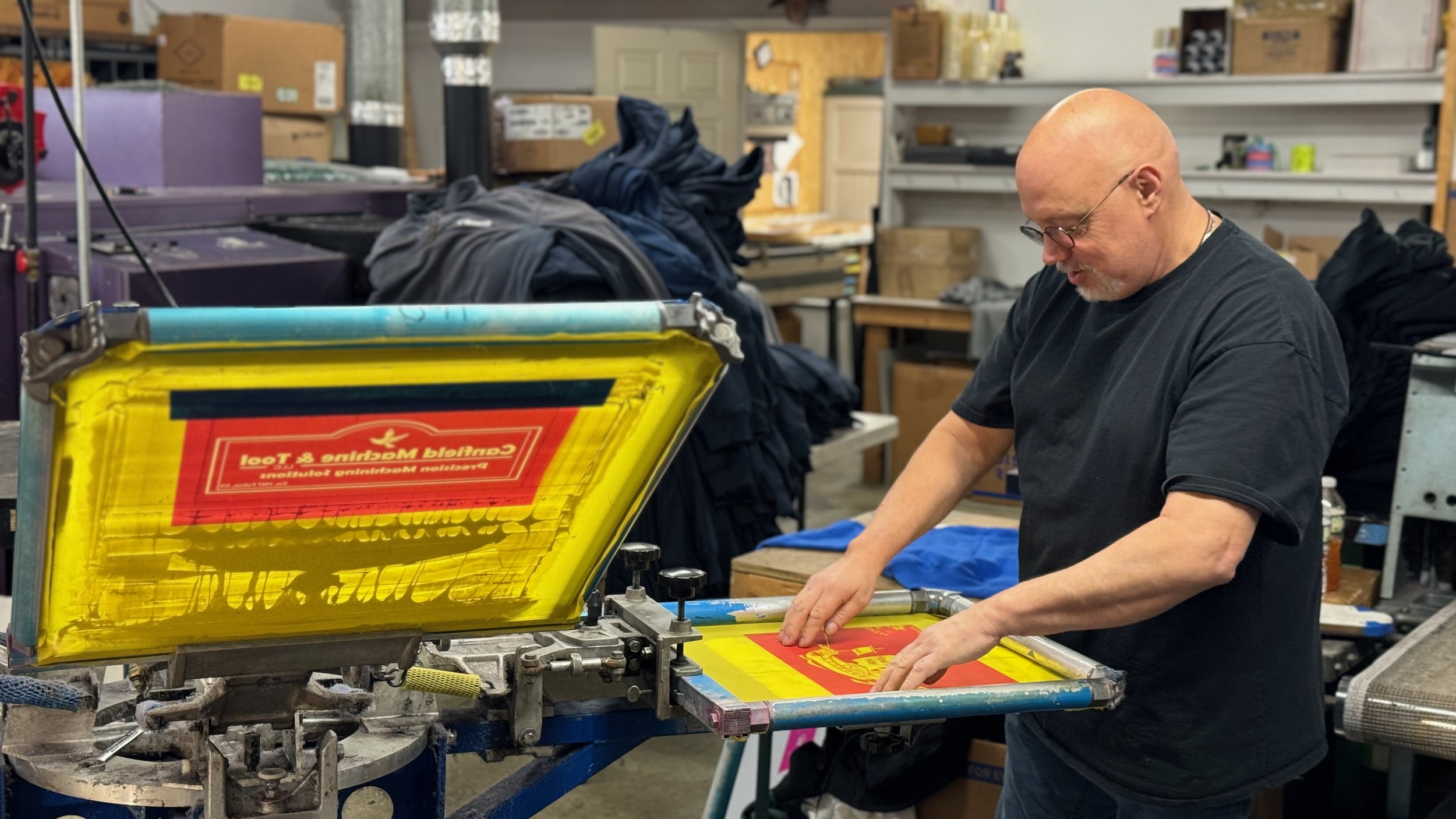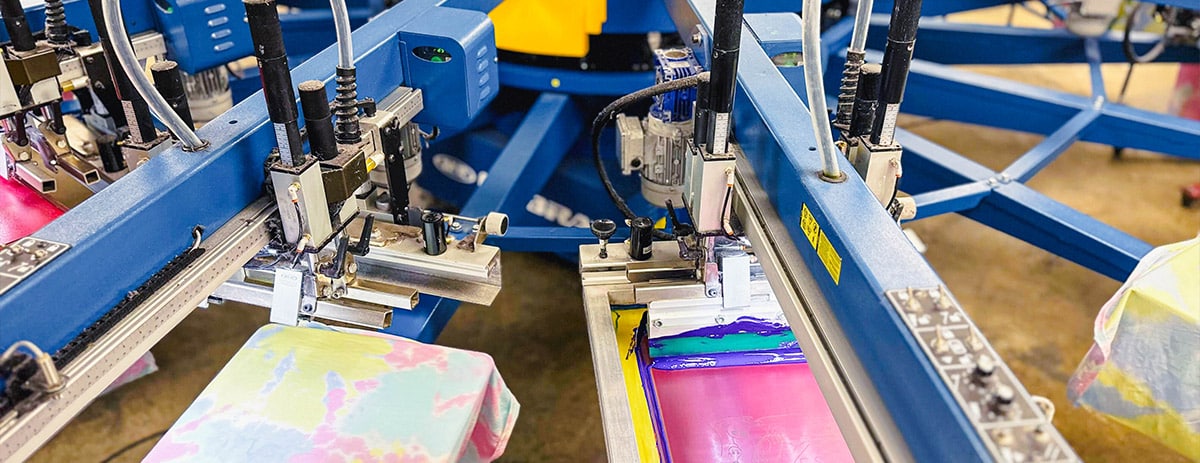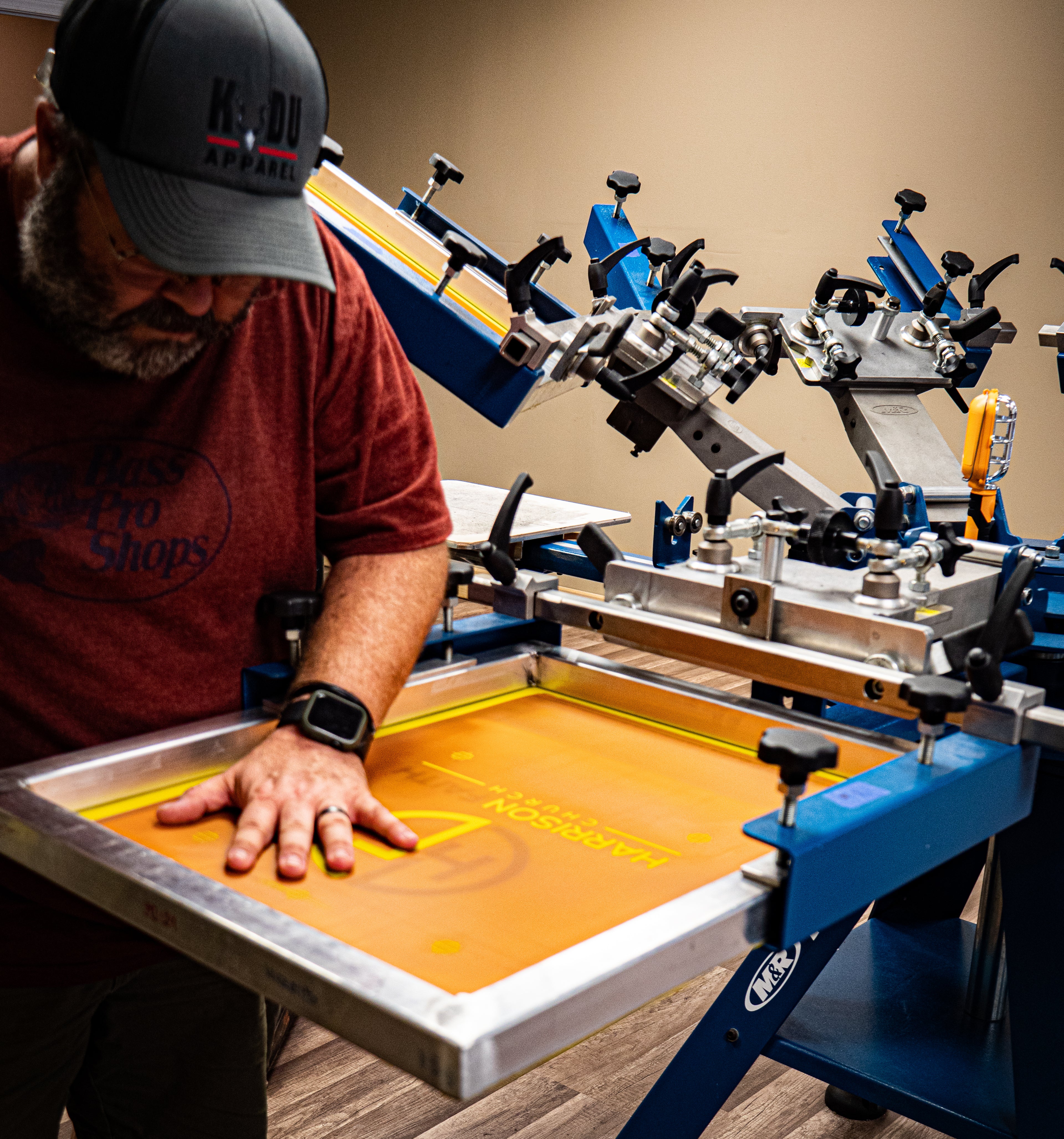Eco-Friendly Custom Screen Printing Options Available
Wiki Article
Display Printing Uncovered: Whatever You Required to Know Concerning T-Shirt and Garment Printing Techniques
Screen printing is a remarkable method that combines art with method, providing countless possibilities for creative thinking. All set to check out the important aspects that make display publishing an art type?
The Basics of Screen Printing: Exactly How It Works
When you plunge right into screen printing, you'll find it's both an art and a science. At its core, screen printing includes producing a pattern, or display, that enables ink to go through only in details areas (screen printing kit). You begin by choosing your layout and preparing your screen with a light-sensitive emulsion. When you expose this solution to light, it sets, leaving your layout as an unfavorable area.Position the screen over the material, then make use of a squeegee to press ink with the display onto the garment. Each step is vital, and grasping them will certainly boost your display printing abilities, transforming easy garments into special, expressive items.
Kinds Of Display Printing Techniques
Once you understand the essentials of display printing, it's time to check out the various strategies that can raise your layouts. One preferred method is standard screen printing, where ink is pressed with a stenciled display. This strategy is great for strong, vibrant shades. There's water-based ink printing, which offers a softer feeling and is environment-friendly, but it requires a different strategy to curing.If you're going for fine information, consider discharge printing. This method eliminates color from the material, leaving a soft, vintage appearance. One more option is plastisol printing, understood for its longevity and vivid colors, making it a preferred for numerous brands. Ultimately, trying out halftone printing to produce slope results and detailed styles. Each strategy has its unique appeal, so don't hesitate to try them bent on locate what fits your style best!
Necessary Tools for Screen Printing
To attain stunning results in display printing, having the appropriate devices is essential. You'll require a sturdy screen printing frame, which holds the mesh that transfers your layout onto the garment. Next, invest in premium mops; these are essential for using ink evenly across the display.Picking the Right Inks and Materials
When choosing inks and materials for display printing, you need to consider the kind of ink that functions ideal for your job. Think of material compatibility to assure your designs look excellent and last long. Likewise, discover eco-friendly ink alternatives to make your printing procedure more sustainable.Sorts Of Screen Inks
Selecting the appropriate display ink is essential for achieving dynamic, resilient prints that fulfill your task's requirements. There are numerous kinds of display inks to examine. Plastisol ink is preferred for its convenience and ease of use, giving excellent color opacity on dark textiles. Water-based ink, on the other hand, supplies a softer feel and is environment-friendly, making it perfect for those aiming to decrease their ecological effect. Release inks eliminate dye from the textile, resulting in a soft, classic look yet call for details handling. Finally, specialty inks, such as metal or glow-in-the-dark, can include distinct effects to your styles. Evaluate your job needs and pick the ink that aligns best with your wanted end result.
Fabric Compatibility Considerations
Comprehending textile compatibility is important for achieving high-grade screen prints, especially because various products respond distinctively to various inks. Constantly check your inks on example textile to guarantee they adhere effectively and preserve color stability. Additionally, keep in mind that fabric weight and texture can impact the last result, so selecting the ideal ink and product combo is vital for your project's success.Eco-Friendly Ink Options
Eco-friendly inks are becoming a prominent option for display printers who want to reduce their environmental influence while keeping top quality. When choosing inks, consider water-based inks, which are much less damaging and much easier to cleanse up contrasted to conventional solvents.Additionally, look for inks made from renewable energies, such as soy or vegetable-based options. By choosing the right inks and products, you'll not just develop spectacular styles yet additionally contribute to an extra lasting printing procedure. Make the switch, and your prints will reflect your dedication to the environment!
Preparing Your Design for Screen Printing

File Format Requirements
To assure your layout looks vibrant and sharp on textile, you'll require to pay close interest to file style needs for display printing. Make sure your design has a clear history to protect against unwanted white edges on your prints. Keep shade settings in mind; CMYK is conventional for display printing, so convert your RGB makes accordingly.Shade Splitting Up Strategies
Shade splitting up is an important action in preparing your layout for screen printing, and mastering it can significantly boost your print top quality. You'll need to break your style into individual colors, as each shade requires a separate screen during printing. Start by recognizing all the shades in your layout and produce layers each. You can use software application like Adobe Photoshop or Illustrator to isolate and different colors efficiently. Be particular to conserve each layer as a separate data, typically in a format like TIFF or PSD. This accuracy not only ensures accurate shade representation however additionally simplifies the printing process. By paying focus to shade separation, you'll achieve dynamic and specialist lead to your screen-printed garments.Resolution and Size
Attaining the very best lead to screen printing begins with guaranteeing your layout has the right resolution and dimension. Preferably, your art work must go to least 300 DPI (dots per inch) for sharp, clear prints. Your last item might look less than professional and pixelated. if you make use of lower resolution.When it involves size, consider the dimensions of your print location. Design your art work to match the final print dimension, preferably producing it in the actual measurements you'll be publishing. In this manner, you'll avoid any unexpected scaling concerns.
Constantly check your style in both vector and raster styles. Vector graphics can be scaled without losing top quality, making them optimal for display printing. Preparing appropriately will assure your design looks remarkable on every garment!
Step-by-Step Display Printing Refine
Screen printing is a vibrant process that permits you to produce vibrant styles on numerous surface areas. To get begun, you'll need a click over here now screen, emulsion, and your selected ink.Pour ink onto the screen and make use of a squeegee to press the ink with the stencil onto the material. Lift the screen thoroughly and let the print dry. You've efficiently screen published your layout.
Tips for Effective Screen Printing Projects
While you're diving into your screen printing tasks, keep in mind that preparation is vital to success. Begin by collecting all your materials-- inks, garments, squeegees, and displays. A clean office assists protect against unwanted mistakes, so clean before you begin.Following, verify your artwork is high-resolution and correctly sized for your garment. Check your display for appropriate exposure and clean it extensively to prevent smudges. When mixing your inks, comply with the supplier's standards discover this to achieve the best uniformity.
During printing, apply also pressure with your squeegee for consistent results. Do not hurry; take your time to validate each print satisfies your standards. After printing, let your garments dry totally before managing or packaging them.
Last but not least, always maintain a sample of your help future reference. This way, you can assess your development and improve your methods gradually. Pleased printing!

Regularly Asked Concerns
Exactly how Lengthy Does It Require To Establish a Display Printing Work?
Setting up a screen printing task generally takes around 30 minutes to an hour. You'll prepare the screens, mix inks, and change the press. The time varies based upon intricacy and experience, so stay organized!Can I Print on Different Material Types Making Use Of the Very Same Method?
Yes, you can print on various material kinds making use of the very same method, however you'll require to change your inks and settings. Some fabrics take in ink in a different way, so experimenting guarantees the very best results for each and every material.What Are Typical Errors to Prevent in Display Printing?
When screen printing, stay clear of common mistakes like utilizing the incorrect ink, disregarding correct direct exposure times, or avoiding pre-press checks. Always check your arrangement and preserve clean screens to assure quality outcomes each time.Exactly How Can I Properly Tidy and Maintain My Display Printing Tools?
To correctly clean and keep your screen printing devices, you must regularly wash displays with ideal solvents, inspect squeegees for wear, and guarantee all tools are kept dust-free and dry. Consistency stops pricey repair work and improves efficiency.Is Display Printing Eco-friendly Contrasted to Other Techniques?
Display printing can be much more environmentally pleasant than other methods, specifically if you make use of eco-conscious products and water-based inks. By picking lasting supplies and techniques, you decrease waste and reduce your effect on the world.Screen Printing Uncovered: Everything You Need to Know About Tee and Garment Printing Techniques
At its core, screen printing includes developing a pattern, or screen, that permits ink to pass through just in specific locations. Position the display over the fabric, after that utilize a squeegee to push ink via the display onto the garment. One preferred technique is conventional screen printing, where ink is pushed through a stenciled screen.When choosing inks and products for display printing, you can try this out you need to take into account the kind of ink that works ideal for your task.
Report this wiki page